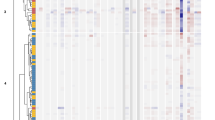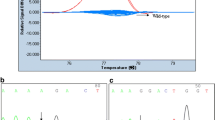Abstract
Using Polymerase Chain Reaction followed by Single Strand Conformation Polymorphism analysis, we studied thirty seven cases of primary human breast cancer for the presence of mutations in exons 5 and 7 of p53 tumour suppressor gene. Only one of the thirty seven tumours tested (2.7%) showed the electrophoretic mobility shift indicative of a mutation in exon 5 of the p53gene, while no such mobility shift was noted in exon 7. Our finding is in contrast to the findings in previous studies, wherein the mutation frequency has been reported to be 13–30% by direct DNA analysis. This may be related to the ethnicity and local population prevalence rather than technique.
Similar content being viewed by others
References
Dhingra K, Hortobagyi GN. Seminars in Oncology 1996; 23(4): 436–445.
Soussi T, de Fromentel C, May PC. Structural aspects of P53 protein in relation to gene evolution. Oncogene 1990; 5: 945–952.
Shimamura A, Fisher DE. p53 in life and death. Clin Cancer Res 1996; 2: 435–440.
Nigro JM, Baker SJ. Mutations in p53 gene occur in diverse tumour types. Nature 1989; 342: 705–708.
Levine AJ, Momand J, Finley CA. The p53 tumour suppressor gene. Nature 1991; 351: 453–456.
Lemione NR. Molecular biology of breast cancer. Ann Oncol 1994; 5(Supl 4): 5312–5337.
Kovach JS, Hartmann A, Balsyzk H. Mutation detection by highly sensitive methods indicate that p53 gene mutations in breast cancers can have important prognostic value. Proc Natl Acad Sci USA 1996; 93: 1093–1096.
Andersen TI, Holm R, Nesland JM, Heimdal KR, Ottestad L, Borresen AL. Prognostic significance of TP53 alterations in breast carcinoma. Br J Cancer 1993; 69: 540–548.
Das BC, Sharma JK, Gopalakrishna V, Luthra UK. Analysis by Polymerase chain reaction of the physical state of the human papilloma virus type 16 DNA in cervical preneoplastic and neoplastic lesions. J Gen Virology 1992; 73: 2327–2336.
Hollstein M, Sidransky D, Vogelstein B, Harris CC. p53 mutations in human cancers. Science 1991: 253. 49–53.
Eeles RA, Bartkova J. The role of the p53 in breast cancer development. Cancer Surveys 1994; 18: 57–75.
Helland A, Holm R. Genetic alterations of the p53 (TP53) gene, p53 protein expression and HPV infection in primary cervical carcinomas. J Pathol 1993; 171:105–114.
Mittal KR, Lin O. Cervical squamous dysplasias and carcinomas with immunodetectable p53 frequently contain HPV. Gynaecol Oncol 1995; 58: 289–294.
Varley JM, Brammer WJ. Loss of chromosome 17p13 sequences and mutation of p53 in human breast carcinomas. Oncogene 1991; 6: 413–421.
Thor AD, Moore DH. Accumulation of p53 tumour suppressor gene protein: An independent marker of prognosis in breast cancer. J Natl Cancer Inst 1992; 84: 845–855.
Coles C, Condie A. p53 mutations in breast cancer. Cancer Res 1992; 52(1): 5291–5298.
Davidoff AM, Kerns BJM. Maintenance of p53 alterations throughout breast cancer progression. Cancer Res 1991; 51: 2605–2610.
Cornalis RS, Vanvliet M. Evidence for a gene on 17p13.3, distal to TP53, as a target for allele loss in breast tumours without p53 mutations. Cancer Res 1994; 54(15): 4200–4206.
Prosser J, Thompson AM. Evidence that p53 behaves as a tumour suppressor gene in sporadic breast tumours. Oncogene 1990; 5: 1573–1579.
Chakravarty G, Redkar, Mittra I. A comparative study of detection of p53 mutations in human breast cancer by flow cytometry, Single Strand Conformation Polymorphism and Genomic sequencing. Br J Cancer 1996; 74: 1181–1187.
Merlo GR, Bernardi A, Diella F, Venesio T, Cappa AP, Callahan R, Liscia DS. In primary human breast carcinomas, mutations in exons 5 and 6 of the p53 gene are associated with a high S-phase index. Int J Cancer 1993; 54: 531–535.
Thoralacius S, Borrensen AL, Eyfjord JE. Somatic p53 mutations in human breast carcinomas in an Icelandic population- a prognostic factor. Cancer Res 1993; 53: 1637–1641.
Gentile M, Bergman Jungestrom M, Olsen KE, Soderkvist P, Wingren S. p53 and survival in early onset breast cancer: analysis of gene mutations, loss of heterozygosity and protein accumulation. Eur J Cancer 1999; 35: 1202–1207.
Author information
Authors and Affiliations
Corresponding author
Rights and permissions
About this article
Cite this article
Makwane, N., Saxena, A. Study of mutations in p53 tumour suppressor gene in human sporadic breast cancers. Indian J Clin Biochem 24, 223–228 (2009). https://doi.org/10.1007/s12291-009-0042-x
Published:
Issue Date:
DOI: https://doi.org/10.1007/s12291-009-0042-x




